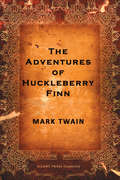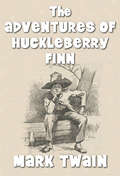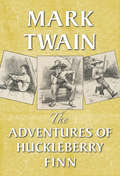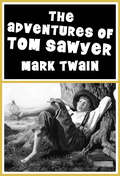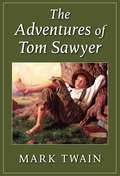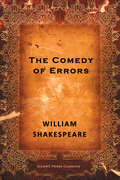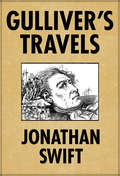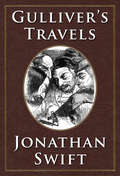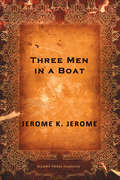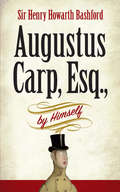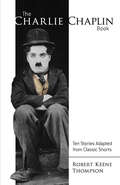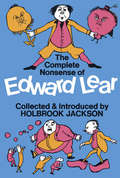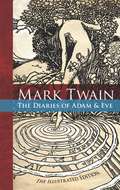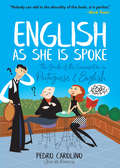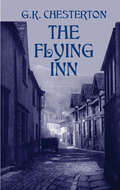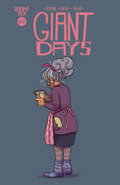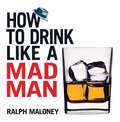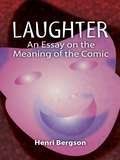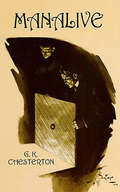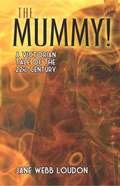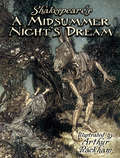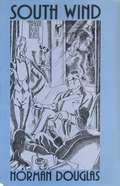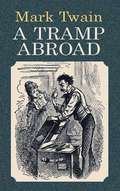- Table View
- List View
The Adventures of Huckleberry Finn
by Mark TwainSequel to Tom Sawyer, The Adventures of Huckleberry Finn is a strong candidate for the Great American Novel. Huck and his friend Jim, an escaped slave, travel down the Mississippi together, having adventures and meeting interesting people, in this satire of the antebellum South. A seminal work of American Literature that still commands deep praise and still elicits controversy, Adventures of Huckleberry Finn is essential to the understanding of the American soul.
The Adventures of Huckleberry Finn (Tom Sawyer's Comrade)
by Mark TwainThe Adventures of Huckleberry Finn has been the subject of much debate since its publication in 1884. The novel has been criticized for its coarse language and racial stereotypes, but it remains a bona fide American classic.
The Adventures of Huckleberry Finn (Tom Sawyer's Comrade)
by Mark TwainA seminal work of American Literature that still commands deep praise and still elicits controversy, Adventures of Huckleberry Finn is essential to the understanding of the American soul.
The Adventures of Tom Sawyer
by Mark TwainWhether forming a pirate gang to search for buried treasure or spending a quiet time at home, sharing his medicine with Aunt Polly’s cat, the irrepressible Tom Sawyer evokes the world of boyhood in nineteenth-century rural America. In this classic story, Mark Twain re-created a long-ago world of freshly whitewashed fences and Sunday school picnics into which sordid characters and violent incidents sometimes intruded. The tale powerfully appeals to both adult nostalgia and young imaginations. Readers explore this memorable setting with a slyly humorous born storyteller as their guide.
The Adventures of Tom Sawyer
by Mark TwainA nostalgic return to the world of 19th-century rural Missouri—a world of endless summers and desperate adventures, seen through the eyes of that most lovable of American heroes. The Adventures of Tom Sawyer recalls the joy and abandon of youth and hearkens back to a simpler time. This is a bona fide American classic.
The Comedy of Errors
by William ShakespeareIdentical twins separated at birth provides the foundation for humour in one of Shakespeare's earlier plays. The young twin sons of Egeon, alongside another set of young twin boys, purchased as slaves, are lost to one another during a tempest at sea. As each searches for the other, the stage is set for a romp that revolves around mistaken identity, physical mishaps, and the comedy of errors referenced in the title.
Gulliver's Travels: Illustrated
by Jonathan SwiftSatirist Jonathan Swift's best known work is the prose satire, Gulliver's Travels, first published in 1726. It is both a satire on human nature and the "travellers' tales" literary subgenre. It tells the story of Lemuel Gulliver and his fantastic journeys. A series of seafaring misadventures take Gulliver to a variety of imagined lands, where he meets the tiny Lilliputians, the enormous Brobdingnagians and many other curious peoples. He is embroiled in political intrigue everywhere he goes, all of which is Swift's comic allegory for religious, political and social events of the day in Europe. Never out of print since its first publication, Gulliver's Travels continues to delight readers today. Swift himself claimed that he wrote Gulliver's Travels "to vex the world rather than divert it".
Gulliver's Travels: Illustrated
by Jonathan SwiftSatirist Jonathan Swift's best known work is the prose satire, Gulliver's Travels, first published in 1726. <P><P>It is both a satire on human nature and the "travellers' tales" literary subgenre. <P>It tells the story of Lemuel Gulliver and his fantastic journeys. <P>A series of seafaring misadventures take Gulliver to a variety of imagined lands, where he meets the tiny Lilliputians, the enormous Brobdingnagians and many other curious peoples. <P>He is embroiled in political intrigue everywhere he goes, all of which is Swift's comic allegory for religious, political and social events of the day in Europe. <P>Never out of print since its first publication, Gulliver's Travels continues to delight readers today. <P>Swift himself claimed that he wrote Gulliver's Travels "to vex the world rather than divert it".
Three Men in a Boat, to say nothing of the dog
by Jerome K. JeromeAgreeing that they suffer from the serious illness of "overwork," J., George, and Harris embark on a boating holiday along the River Thames. Travelling from Kingston to Oxford, the three men prove themselves wholly unprepared for the journey, and document their misadventures with comedic brilliance.
Augustus Carp, Esq.: by Himself
by Henry Howarth BashfordMeet our memoirist, Augustus Carp, a self-proclaimed "good man" who relishes every opportunity to condemn the weaknesses of others while excusing his own failings. In this spoof autobiography, the pompous narrator enthusiastically recounts his mundane achievements with unwitting hilarity, making frequent asides to bemoan the sins of lesser mortals. Much of the story's ironic humor derives from his delivery; the more seriously Carp takes himself, the more ridiculous he appears. This riotous fable is supported by a cast of delightfully eccentric and grotesque characters: Abraham Stool, manufacturer of the famous Adult Gripe Water; schoolteacher Mr. Beerthorpe, inevitably known to his charges as "Beery"; the Rev. Eugene Cake, author of such improving fiction as Gnashers of Teeth; and other memorable personalities. A cult classic and comic gem, the book was originally published anonymously in 1924 and rediscovered decades later, when its author was revealed as a genteel (and discreet) London physician. This edition features the splendidly droll illustrations by Punch artist Marjorie Blood from the original publication.
The Charlie Chaplin Book: Ten Stories Adapted from Classic Shorts
by Robert Keene ThompsonBeloved around the world for his Little Tramp character, Charlie Chaplin was the most famous person on the planet during the early twentieth century, and his popularity endures to this day. Cinephiles and Chaplin aficionados will rejoice in these expert novelizations by a famed Hollywood screenwriter of the scripts for ten short films Chaplin made in 1915 for the Essanay Company of Chicago. The Bank: A bank janitor develops romantic designs on a secretaryA Woman: An eager suitor cross-dresses to deceive a disapproving father Work: A paperhanger's assistant wreaks havoc on a stately mansionThe Champion: A pet bulldog helps his master go for broke in the boxing ring His New Job: A prop man at a movie studio is given a chance to actBy the Sea: A bathing resort provides the backdrop for a series of comic adventuresA Night Out: A pair of friends go on a bender, spreading pandemonium in their pathThe Tramp: An admirer of a farmer's daughter is thwarted by a rivalIn the Park: A couple of star-crossed lovers receive help from a kindly CupidA Jitney Elopement: A Romeo rescues his sweetheart from an arranged marriage
The Complete Nonsense of Edward Lear
by Edward LearHere is every line of every nonsense book written by Edward Lear. In a single volume you get "A Book of Nonsense," "Nonsense Songs," "More Nonsense Songs," "Laughable Lyrics," and "Nonsense Songs and Stories. No other low-price edition offers this complete collection.You will meet such old favorites as "The Dong With a Luminous Nose," "The Jumblies," "The Owl and the Pussycat," "The Nutcrackers and the Sugar Tongs," and "The History of the Seven Young Owls." Two hundred and fourteen limericks are in here as well, each illustrated with the drawing Lear composed specially for it. In addition, you'll find three different sets of Nonsense Botany, five Nonsense Alphabets, and dozens of other selections in both prose and verse.All 546 of Lear's original illustrations are in this volume. With masterful simplicity and apparent naiveté they tell of the dreamlike never-never land of childhood. Many Lear enthusiasts maintain that in these drawings the Laureate of Nonsense gave rise to an entire new style. Their influence has certainly been widespread, with echoes of Lear to be seen in the work of Thurber, Steinberg, Phil May, Bateman, and other artists and illustrators.It has been a hundred years since Edward Lear, the advocate of illogic, first became known to a wide public. Children who begged to have his verses read to them have grown up to read Lear to their own children — and to discover that his whimsy, imagination, and originality have their attraction for the adult mind as well.
The Diaries of Adam and Eve (Modern Library Mini Ser.)
by Mark Twain Lester Ralph F. StrothmannThe great American humorist's "translations" of journals by the first man and woman offer a comic "he said/she said" narrative. An irreverent look at conventional religion, the book presents a thoughtful argument for the equality of the sexes. This special edition features outstanding illustrations by F. Strothmann and Lester Ralph on every page.
English as She Is Spoke: The Guide of the Conversation in Portuguese and English
by Mark Twain Pedro CarolinoThe Guide of the Conversation in Portuguese and English
The Flying Inn
by G. K. ChestertonAn exuberant man as well as a prolific and gifted writer, G. K. Chesterton (1874–1936) was a man with very strong opinions — and extremely capable of defending them. In this hilarious, satirical romp, Chesterton demonstrates his intense distrust of power and "progressives," railing against Prohibition, vegetarianism, theosophy, and other "dreary and oppressive" forces of modernity.In a spirited response to the government's attempt to curtail alcohol sales, Humphrey Pump (called Hump) — a pub owner in the fishing village of Pebblewick — takes to the road in a donkey cart. Accompanied by Captain Patrick Dalroy, a crimson-haired giant with a tendency to burst into song, Hump provisions the cart with a cask of good rum, a giant round of cheese, and the signpost from his pub, The Flying Inn. Together, the two men extend good cheer to an increasingly restless populace as they attempt to evade Prohibition. In a journey that becomes a rollicking madcap adventure, the two travel round England, encountering revolution, romance, and a cast of memorable characters.Sure to receive an enthusiastic welcome from Chesterton fans, this new edition of an old classic will also appeal to anyone who enjoys a humorous, well-crafted tale.
Giant Days #37 (Giant Days #37)
by John Allison Max Sarin Whitney CogarIntroducing your girlfriend to your family can be difficult, but it’s much worse when that girlfriend is Ingrid.
How to Drink Like a Mad Man
by Ralph MaloneyBetween the three-martini lunches and Scotch around the clock, it's hard to believe that advertising executives in the Sixties could remain conscious, let alone conduct business. How did they do it? The answer lies in this authentic document from Madison Avenue, circa 1962. Learn the secrets behind calling in sick, avoiding phone calls, and other boardroom shenanigans. "So side-splittingly funny, yet so dark with doom." -- Boston Herald.
Laughter: An Essay on the Meaning of the Comic
by Cloudesley Brereton Fred Rothwell Henri BergsonIn this great philosophical essay, Henri Bergson explores why people laugh and what laughter means. Written at the turn of the twentieth century, Laughter explores what it is in language that makes a joke funny and what it is in us that makes us laugh.One of the functions of humor, according to Bergson, is to help us retain our humanity during an age of mechanization. Like other philosophers, novelists, poets, and humorists of his era, Bergson was concerned with the duality of man and machine. His belief in life as a vital impulse, indefinable by reason alone, informs his perception of comedy as the relief we experience upon distancing ourselves from the mechanistic and materialistic. "A situation is always comic," Bergson notes, "if it participates simultaneously in two series of events which are absolutely independent of each other, and if it can be interpreted in two quite different meanings." The philosopher's thought-provoking insights (e.g., "It seems that laughter needs an echo. Our laughter is always the laughter of a group.") keep this work ever-relevant as a thesis on the principles of humor.
Manalive
by G. K. ChestertonPerhaps the most light-hearted of all Chesterton's "serious" works, Manalive pits a group of disillusioned young people against Mr. Innocent Smith, a bubbly, high-spirited gentleman who literally falls into their midst. Accused of murder and denounced for repeatedly marrying his wife and attempting to live in various houses (all of which turn out to be his own), Smith prompts his newfound acquaintances to recognize an important idea: that life is worth living.
The Mummy!: A Victorian Tale of the 22nd Century
by Jane Webb LoudonWithin a decade of the 1818 publication of Mary Shelley's Frankenstein, another Englishwoman invented a foundational work of science fiction. Seventeen-year-old Jane Webb Loudon took up the theme of reanimation, moved it three hundred years into the future, and applied it to Cheops, an ancient Egyptian mummy. Unlike Shelley's horrifying, death-dealing monster, this revivified creature bears the wisdom of the ages and is eager to share his insights with humanity. Cheops boards a hot-air balloon and travels to 22nd-century England, where he sets about remedying the ills of a corrupt government.In recounting Cheops' attempts to put the futuristic society to rights, the young author offers a fascinating portrait of the preoccupations of her own era as well as some remarkably prescient predictions of technological advances. The Mummy! envisions a world in which automatons perform surgery, undersea tunnels connect England and Ireland, weather-control devices provide crop irrigation, and messages are transmitted with the speed of cannonball fire. The first novel to feature the concept of a living mummy, this pioneering tale offers an engaging mix of comedy, politics, and science fiction.
Pieces of Perfect (Pieces Series #1)
by Elizabeth HayleyAs a sexy ex-hockey player, Max was the bad boy with something to prove. As a handsome single father, Adam was the man most women wait a lifetime for. Each man would take me on a journey of self-discovery that was marred with lies, jealousy, deceit, and a whole lot of fun. They each offered a glimpse of happily ever after, a piece of perfect. But in my constant quest to have it all, I would risk losing everything. Only one thing was certain. I’d never be the same after this.
Shakespeare's A Midsummer Night's Dream
by William Shakespeare Arthur RackhamShakespeare's incomparable romantic comedy takes on a new and vivid life in these brilliant images by one of the 20th century's leading illustrators. The fairy world of A Midsummer Night's Dream is the perfect milieu for the artistry of Arthur Rackham, a popular illustrator of fairy tales who possessed a striking gift for depicting fanciful creatures. His dreamlike visions provide a series of unique portraits from the enchanted wood outside ancient Athena, where Oberon and Titania rule a kingdom of diminutive sprites. <p><p> Rackham's career coincided with the era known as the Golden Age of Illustration, an age that witnessed the rise of increasingly sophisticated color printing techniques. His interpretation of A Midsummer Night's Dream, which first appeared in 1908, received the full benefit of the improved technology, and this faithful reprint offers a quality of printing and sharpness of reproduction that rivals the limited and first editions. The complete text of the play appears here, along with 40 full-color and numerous black-and-white illustrations — a splendid tribute by a master of fantasy art to an immortal play.
South Wind
by Norman DouglasIn this witty novel of ideas, an intellectual and sensual adventure of the rarest kind unfolds amid a picturesque Mediterranean island. Generations of readers have delighted in the tale of an English clergyman's visit to a "rambling and craggy sort of place," where whitewashed houses perch on sheer rock cliffs above a gleaming sea. But underneath its tranquil surface, the island seethes with volcanic activity. And behind the aristocratic discourse on life and love lies a tangle of nefarious activities, from art forgery to murder. A memorable cast of characters includes the genteel visiting bishop as well as an elderly diplomat, a devilish magistrate, a malevolent barkeeper, and a host of other expatriates, freethinkers, eccentrics, zealots, and ne'er-do-wells. Their interactions generate a volatile mixture of notions that prove as unsettling as the sirocco, the hot, damp wind from the south. Combining elegant prose with glittering epigrams, mordant satire, and memorable characterization, this story offers thought-provoking entertainment.
A Tramp Abroad (World Classics Ser.)
by Mark TwainThe success of Twain's first collection of travel memoirs, The Innocents Abroad, inspired a return to Europe for another look at some of the countries and landmarks that initially dazzled the author and his companions. In A Tramp Abroad, Twain's abundant humor waxes as freely as ever; this time, however, his amusement bears a more cynical cast, as he regards the grand tourist sights in Innocents through older and more experienced eyes. The seriousness of the author's second impressions provides an interesting subtext to the overall jocularity of his narrative, making this volume a milestone in the Twain oeuvre and a must for his legions of admirers. Appendix.
Cousin Betty
by Honoré De BalzacLa Cousine Bette (French pronunciation: [la kuzin bɛt], Cousin Bette) is an 1846 novel by French author Honoré de Balzac. Set in mid-19th century Paris, it tells the story of an unmarried middle-aged woman who plots the destruction of her extended family. Bette works with Valérie Marneffe, an unhappily married young lady, to seduce and torment a series of men. One of these is Baron Hector Hulot, husband to Bette's cousin Adeline. He sacrifices his family's fortune and good name to please Valérie, who leaves him for a tradesman named Crevel. The book is part of the Scènes de la vie parisienne section of Balzac's novel sequence La Comédie humaine ("The Human Comedy").
